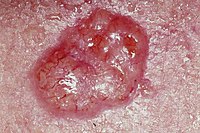
Photo from wikipedia
Ultrasound (US) or sonography is the most common diagnostic non-invasive imaging method, which is estimated to account for more than a third of all diagnostic procedures used in medical practice.… Click to show full abstract
Ultrasound (US) or sonography is the most common diagnostic non-invasive imaging method, which is estimated to account for more than a third of all diagnostic procedures used in medical practice. Traditionally, US frequencies used in diagnostic radiology range from 1 MHz to approximately 16 MHz. Visualization of skin morphology requires US frequencies from 20 to 100 MHz, and is called a “high frequency ultrasound” (HFUS). HFUS has been explored in normal skin and in various skin pathologies. It has been found useful in differentiation diagnosis of infiltrative (perivascular) and exudative inflammation, hypertrophic or normotrophic scars, keloids, and in skin atrophy. Moreover, it has been used to support diagnosis and management of skin tumors. In skin oncology, HFUS can provide essential information on tumors’ size and margins, particularly the depth of invasion. Such information are crucial in deciding on the form of treatment (e.g., photodynamic therapy, radiotherapy, brachytherapy), computed tomography (CT)-based planning treatment (e.g., superficial brachytherapy), and in skin monitoring after treatment, in addition to clinical examination.
Journal Title: Journal of Contemporary Brachytherapy
Year Published: 2021
Link to full text (if available)
Share on Social Media: Sign Up to like & get
recommendations!